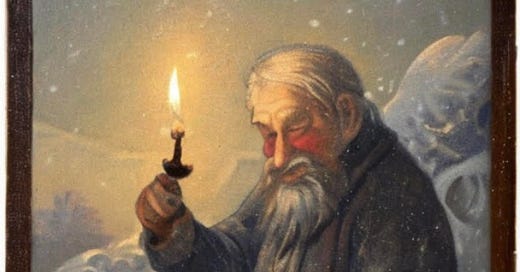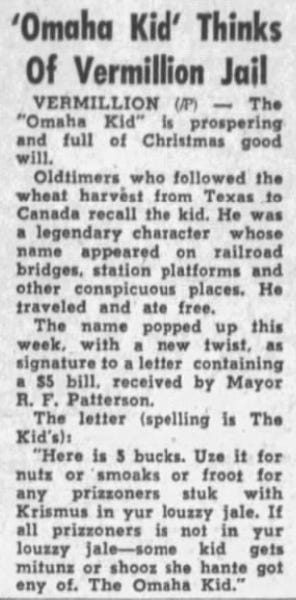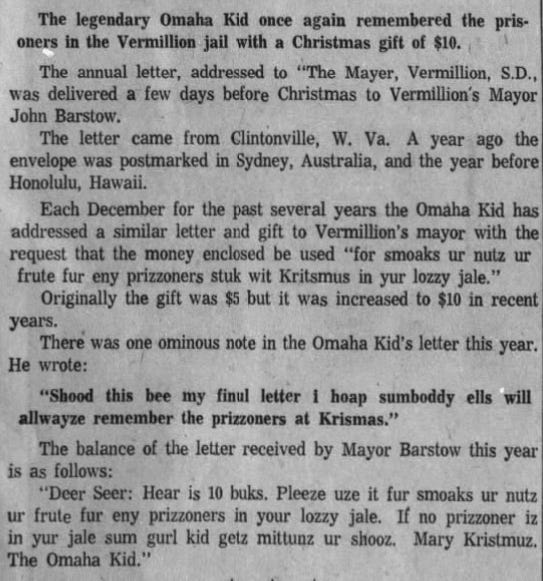The Bankhead Gleaner: My Gain of Function Commonplace Book, December 21, 2023
Making Light of Darkness
Hello, friends. Here’s a miscellany for you on this darkest day of the year. May the practiced planet pause, perform its perfect pivot, and promptly propel us back towards the light.
1.
Let’s begin with some no-nonsense advice for those who fear the dark:
2.
Christmas is a season for list-making, of course — shopping lists, to-do lists, want lists. Now and again, over the years, newspapers have published novelty stories about wish-lists written by jailbirds that were posted to Santa in the big house mailbag only to be retrieved by wardens, and leaked to the press. I’ve found a number of these, from the 1920’s - 1950’s, and from them have culled this short catalogue of items requested by inmates in whom hope’s childish ember still burns. (Note how the game of checkers comes up here, as it does in the Dear Abby column above. Coincidence!)
Two forty-five automatics, Colts preferred
One Tommy-gum
One T-Model Ford
One acetylene torch
A hack saw
50 feet of strong nylon rope
A pair of track shoes
A pardon from the governor
Walking papers
Checker games
3 quarts of bourbon
2 quarts each of cherry liqueur and rum
2 cases of beer
2 large pizzas
Here’s one such letter, typical of the rest. This was published in The Eugene (Oregon) Guard, December 12, 1956.
3.
This wasn’t the first time the prison at Klamath Falls, Oregon, had been front and centre in such a story. On December 21, 1928, the following verse was published in the Klamath News; it’s said to have been received by the editor charged with opening the many letters to Santa which the paper routinely received. The sincerity of the sentiment compensates for the lapses in scansion.
Klamath Co. Jail. December 15, 1928.
Dear Santa —
Well, Old Timer, how are you?
It’s tough on us and that is true;
We’re locked in jail behind the bars,
Not out in the open ‘neath the moon and the stars.
It’s what we are, not what we’ve been,
We’re supposed to be men who don’t fit in,
There are men in here who should be out,
While some on the outside roaming about
Are very unprincipled and should take a “ride,”
But our fate’s for a jury to decide.
I know that your heart is not one of greed,
So I’ll ask for a few things that we need.
Of things we’d appreciate and sure could use
Is about three pairs of serviceable shoes.
One man wears eights, another size seven,
Sixes for me would be a gift from heaven.
It’s really a fact, my feet are sore,
My bare feet touch the concrete floor.
What would you give, we’d appreciate:
Some fruit and nuts would sure be great.
Take care of the kiddies, each girl and boy,
And make them happy by giving a toy.
Though we are men, some old ones, too,
Some things we’d appreciate I’ve asked of you.
We’re too old to play with a child’s toy,
But not too old to wish you joy.
If gifts we receive, it’s you we’ll thank:
Inmates of the bastile, East-side Tank.
4.
For a few years, whatever prisoners might have been in the pokey in the small city of Vermilion, South Dakota (present population approx 12,000) were in receipt, via the mail, of the small but intriguing Christmas munificence of someone calling himself (“him” as I suppose) “the Omaha Kid.” He was, apparently, someone with hobo bonafides: a migrant worker, a rail-rider, a tagger.
The subsequent letters came from Chicago or Colorado or Florida or Dallas, even from farther afield. They included a cheque for five or ten dollars and a note written, as above, in a style so phonetic and homespun that it must surely have been a contrivance. This is a clipping from the Argus Leader, in Sioux Falls, December 30, 1962.
The next year’s missive came from Dallas, and included the message: “I am very sorry Prezident Kennedy wuz kilt. He was a good man. Mary Cristmus, The Omaha Kid.”Colorado was the point of origin in 64, Chicago in 65, and after that, nothing.
Who was the Omaha Kid? It was the professional name of a bantamweight boxer, Oscar Gardner, who was in 547 fights in the ring before he died, of occupationally sustained injuries, on Boxing Day, in 1928. So Oscar was not a contender, not for the title of Menschiest Cheque Writer. I suspect it’s one of those sweet mysteries of life that that lie beyond solving, and that we best honour not by prying or asking too many questions or by bringing the powers of AI to bear, but simply by remembering that once it was and, if only for a moment, by caring that someone thought to do it.
5.
Here’s Richard Burton with a fine reading of John Donne’s “Nocturnal Upon St. Lucy’s Day, Being the Shortest Day,” a poem that for four hundred years has been fit for every winter solstice purpose.
6.
Sixty years ago at Christmastime, in 1963, Elizabeth Taylor and Eddie Fisher were in the courts (not least of public opinion), hammering out the details of the divorce that would free her up to marry Richard Burton. A few years later, in 1968, Burton gave to Taylor a remarkable ring, a ruby as big your eye, set with diamonds. It was presented as a stocking stuffer, and E.T. remembered the moment of its delivery in her book, My Love Affair With Jewelry.
I opened the box very, very slowly. Inside it glowed with the fire of the most perfect colored stone I’d ever seen. With the most perfect cut. I’m sure I almost fainted. I screamed, which probably echoed over the mountains, and I couldn’t stop screaming. I knew I was staring at the most exquisite ruby anyone had ever seen.
I, Bill Richardson, reacted much in the same way, in the same year, when I got an Etch-A-Sketch.
7.
Finally, here’s a real gem, remarkable example of the correspondence between Nellie Lender Brooks, of Rugby, Tennessee, and Lucy Curtis Templeton. Mrs. Templeton received the letters at the Knoxville News-Sentinel, and published them in her column “A Country Calendar.” These aren’t Christmas specific, necessarily, but as both women were very much beacons in their communities, I thought to feature them during these darkest of days. This story — from “A Country Calendar,” December 16, 1945 — is redolent of the forest primeval, and will appeal to anyone for whom “Peter and the Wolf” is a Christmas tradition. It’s a great story of the Brooks family, with their branches in Fentress and Morgan counties, and a gripping piece of local lore, too. Just to note, Mrs. Brooks got the dates just little bit wrong. The wolf was captured in 1924, not 1925. (see clipping that follows) Thanks for reading, BR
Lucy writes:
I have often deluded myself with the idea that I should have liked to live in pioneer days, when bears, wolves, panthers, and even Indians roamed the ridges and valleys around Knoxville. In my more realistic moments, I know very well that I probably would not have liked it at all.
A great many persons of whom I am one also feel strongly the picturesque pull of the middle ages. Life in those days was certainly full of excitement and romance for the men of the family. But the women, cooped up all winter in cold and evil-smelling castles with nothing to do except supervise their servants, gossip, and work a few feet of tapestry, must have had a pretty dreary time.
Of course, what we do in both instances is to seize upon the romantic, highly coloured incidents and disregard the dirty and the sordid. And, since it is man's happy faculty to forget the disagreeable, it is the glamour and the excitement about both these periods that we remember.
However that may be, for some reason or another I always get a thrill out of such bits and tatters of savage life as occasionally crop out in these decadent days. To hear, for example, that a wild cat had been killed near Hickory Star landing week before last. Not that it had been killed. I should greatly have preferred that it had chased someone's dog back home, but as I say, we have to be contented with such shreds of adventure as come our way.
And apropos of wild animals, Mrs. C. C. Brooks, of Rugby, has sent us an account of the killing of what must have been the last wolf in Fentress County. It was in 1925, Mrs. Brooks believes that her husband's brother, H. M. Brooks, trapped the wolf that had been a great killer, destroying 86 sheep for one man, Jesse Roysden, besides many other sheep, hogs, calves, and dogs. County Court offered $200 for its scalp. Many hunts were organized, but the dogs would not follow its tracks as they sensed danger.
“Wolf hounds were brought from Virginia without success, and a platform was built in a tree whence the hunters watched all night for his beaten track.”
The region ravaged by the wolf was a wild sparsely settled country with many rocky, riverside retreats bordering on the Big South Fork of the Cumberland. And now comes the most interesting part of the story. Mr. Brooks' son-in-law and daughter, Mr. and Mrs. Grover Stockton, had a young fox terrier which they noticed would get restless every night and want to be let out of the house.
“Mr. Stockton followed and saw the dog playing with the wolf. Mr. Brooks had heard that any wild animal would always follow a fresh furrow in a plowed field. … He raked a long path and strewed it with sardines. Next morning the sardines were gone. Then followed the building of small earth mounds, about every 30 feet with four traps set between. The tracks showed the wolf walked around the fresh mounds and always back to the raked path. The second night of the placement of these mounds, the wolf was caught by one of his front feet. G. Stockton found the wolf and, after a marvellous tussle, got a long chain attached to the trap around a tree. Finally the wolf was imprisoned in a box. The captive was exhibited for a while, but sickened and was shot.
It will be seen that this wolf was killed many years after the one of which Will Rule wrote us lately. Where either of them came from is a question. They may have been lone survivors of original stock. On the other hand, there have been several instances of timber wolves escaping either from traveling shows or after being brought to this region as pets. Wolves usually travel in packs, and a lone wolf as a rule is not indigenous. However, it is a grand story, especially the part about the little dog going out every night to play with the savage giant that had killed so many bigger dogs.













OMG! Klamath Falls! A good place to be from....